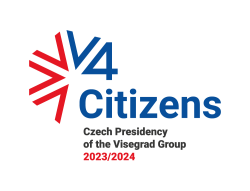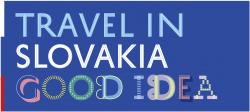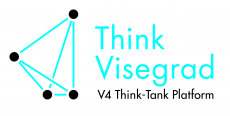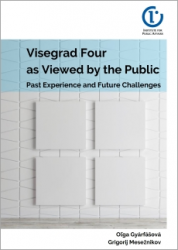
| Wed | Thu | Fri | Sat | Sun |
|---|---|---|---|---|
| 8 | 11 | 14 | 20 | 23 |
| Wed | Thu | Fri | Sat | Sun |
|---|---|---|---|---|
| 10 | 12 | 15 | 21 | 24 |
| Wed | Thu | Fri | Sat | Sun |
|---|---|---|---|---|
| 10 | 13 | 16 | 18 | 21 |
| Wed | Thu | Fri | Sat | Sun |
|---|---|---|---|---|
| 11 | 13 | 17 | 21 | 25 |
We, the Visegrad Citizens, Neighbours and Allies
How societies in V4 countries perceive each other and the format of the Group?
Judging by the intensity of political communication our regional cooperation seems to be flourishing. However, public opinion research brings a sobering reflection on how societies in V4 countries perceive each other and the format of the Group.
The Visegrad Group is primarily a political project. But the “flash and blood” of the living organism is given by the civil societies commitments, by the citizens´ contacts and mutual interactions. And what do the citizens of particular countries think about the V4? Do they actually know what the Visegrad Four is, is it a visible “brand” or not? To what extent do the Visegrad citizens trust each other? What is the intensity of their mutual interactions?
The answers to these questions, which represent an important dimension of inner cohesion of the Visegrad, can be found in the research project “Perception of the Visegrad cooperation in V4 countries“, conducted in 2015 on the initiative of and with financial support from the International Visegrad Fund.
The project was coordinated by the Institute for Public Affairs in Bratislava. The data from a representative sample of adult population of the four countries were gathered by the following research agencies: STEM (Czech Republic), Tárki (Hungary), Stratega Market Research (Poland), and FOCUS (Slovakia). The current project is a follow-up to similar public opinion polls conducted in all V4 countries in 2001, 2003, and 2011.
Visibility and awareness of relevance
The findings showed that the highest level of awareness of the V4 and Visegrad cooperation is in Slovakia: 54% of Slovak respondents said they heard of the Visegrad Group and knew what it was about, compared to 37% of the Czechs, 26% of the Hungarians, and only 17% of the Poles. This fact reflects the high interest of Slovak political representation in intense political cooperation within the V4 that can be “traced” back to the period when Slovakia struggled to return to the road of EU integration after the 1998 parliamentary elections. “Slovakia’s road to Brussels goes via Visegrad”, was the popular saying of those years.
Strategic objectives of Visegrad as they had been set up in early 1990´- have been met by consolidating democracy and joining EU and NATO. Has the Visegrad still any mission? Is it still relevant? Positive response comes from all four countries cooperation but its magnitude varies: Visegrad cooperation is considered as meaningful and important by 70% of Slovaks, compared to about 50% of the Czechs and 40% of the Hungarians and the Poles. Still, V4 cooperation actually does not have any opponents.
The public support for V4 cooperation can be compared with data from 2003: Slovakia has kept the highest level of support, however, in Poland and Hungary the support for and the belief in the meaning of V4 cooperation decreased over the last 12 years, in Poland by as much as 21 percentage points. On the other hand, the Czech public is more inclined towards the cooperation within the Visegrad Group than 12 years ago (Graph 1).

The decreased level of public awareness in Poland and Hungary may have different reasons. Compared to its partners within the Visegrad Group, Poland is a regional power, a key political actor, and the Poles can feel that they are in a different league. In the past, the destiny of Polish nation and Polish statehood directly depended on the development of relations between Poland on one hand, and Germany and Russia on the other hand (as well as on mutual relations between the two states).
The public views of state’s foreign policy have been definitely shaped by the attitudes of a significant proportion of Polish political and cultural elite, which attach special importance to the interaction of Poland and the two countries with respect to Poland’s current position. Another influential factor can be considered the current global events with active participation, be it positive or negative, of Germany and Russia. The two countries have recently become visible mainly in connection with Russia-Ukraine conflict – Russia as an aggressor, and Germany as a proponent of Western Europe’s firm stance on Russian aggression.
In Hungary, the decrease in the level of public awareness of the V4 might have been caused by inner political changes and foreign policy priorities other than those relating to Central Europe. A common denominator of the decreasing trend in the two countries can be the feeling of reduced relevance of the group compared to the period when the countries joined their forces to cope with individual milestones of European integration and the common action within the region represented an added value.
A different case represents the Czech Republic. In the mid-1990s the Czech society basked in the EU’s favourable approach, relishing its “star pupil of integration” title. Václav Klaus, the Prime Minister and later also as the President of the Czech Republic, repeatedly labelled Visegrad cooperation as an obsolete concept. Today, the situation is quite different. The Czechs’ political elites revived interest in cooperation within the V4 format is clear, which is reflected in the support of the general public.
The aforementioned comparison shows that the public awareness of the Visegrad cooperation and the perception of its importance can change easily; it is not given once and forever. The views of citizens respond, to a certain extent, to a broader range of global events and reflect current political preferences. Political elites must never stop trying to enhance the public awareness and interest.
Mental map of the Visegrad Group
The nations of the Central European region carry a huge historical burden from their common past. Interpretation of history often reveals that everyone feels they are owed something, and everybody did harm to someone else at some point. On the other hand, the nations are unified by the closeness of their common destiny which sets the grounds for mutual trust.
Based on surveys we see that the Czechs and Slovaks share the strongest ties of confidence. This level of trust and above-standard relationship seemed to be the utopian dream until around the split of the Czechoslovak federation in 1992-1994. But recently the commonalities and the joint history represent a strong background for good relations – the two nations became the most amicable of divorced couples.
Poles have very balanced relations with the other three nations, and, of course, the most sensitive is the question of trust between Slovaks and Hungarians. However, many bridges have been built in recent years to overcome the historically conditioned distrust. Okay, but what about the world beyond Visegrad and its allies?
The simplest indicator of mutual relations among V4 countries (and their relations to other states) is trust and the feeling of the public that they can rely on the other country.
The strongest level of trust towards other V4 nations can be observed in Poland, where they occupied top three positions on the scale of trustworthiness: Slovaks ranked first with 69%, followed by the Czechs (61%), and Hungarians (61%). Within the Visegrad “sociogram of trust” the highest level of trust can be observed between the Czechs and the Slovaks – almost four fifths of respondents in the two republics trust the other country.

Over the last few years, the closeness of the Czech Republic to the Slovak public (and vice versa – closeness of Slovakia to the Czech public) has also been proved by other surveys. In Slovakia, the most trustworthy are the Czechs (78%), Austrians (49%), and Poles (40%), while Hungarians took only the ninth place (30%).
 In the Czech Republic, the ranking is quite different: the Slovaks (79%) and French (59%) are followed by Poles, Britons and Austrians (58% each), while the Hungarians with 37% took the ninth place. Hungary is the only V4 country, where the public shows the highest level of trust towards the country outside the Visegrad Group – Germany (62%). Poland was ranked second (58%), while the Czech Republic and Slovakia (40% both) share the fourth and the fifth places.
In the Czech Republic, the ranking is quite different: the Slovaks (79%) and French (59%) are followed by Poles, Britons and Austrians (58% each), while the Hungarians with 37% took the ninth place. Hungary is the only V4 country, where the public shows the highest level of trust towards the country outside the Visegrad Group – Germany (62%). Poland was ranked second (58%), while the Czech Republic and Slovakia (40% both) share the fourth and the fifth places.
 In general, the level of trust among the V4 inhabitants is rather high. Even the Slovak-Hungarian relations, formerly the “Achilles’ heel” of the Visegrad cooperation, have never been better. While in 2011 only 16% of Hungarians trusted Slovaks, in 2015 this proportion increased to 40%. A slight improvement can also be seen in Slovakia, where the share of those who trust Hungarians increased from 26% to 30% in the same period.
In general, the level of trust among the V4 inhabitants is rather high. Even the Slovak-Hungarian relations, formerly the “Achilles’ heel” of the Visegrad cooperation, have never been better. While in 2011 only 16% of Hungarians trusted Slovaks, in 2015 this proportion increased to 40%. A slight improvement can also be seen in Slovakia, where the share of those who trust Hungarians increased from 26% to 30% in the same period.
Slovak public still takes a more reserved attitude towards Hungary compared to other countries; however, based on the aforementioned indicators, this wariness seems to be weakening. The mutual perception of Slovaks and Hungarians have also been positively influenced by the fact that despite ideological differences and previous experiences, burdened with tension and confrontation, the current ruling parties – Smer-SD (Direction – Social Democracy) in Slovakia and Fidesz in Hungary – managed to establish and maintain correct and trouble-free pragmatic relations.

Apart from the V4 countries, the inhabitants in these countries trust their significant Central European neighbour, Austria. In the list of trustworthy countries Austria is followed by Germany, the United Kingdom, and France.
For a long time, the V4 countries have had different attitudes towards Russia. Poles feel the highest degree of distrust of Russia; on the contrary, the Slovaks feel the highest degree of trust towards this country. While in Poland the distrust towards Russia is deeply rooted in historical experiences and encouraged by the current political discourse, Slovaks perceive Russia in a more positive way despite their bad experiences, for instance the invasion of Czechoslovakia by the Warsaw Pact armies in August 1968 and the subsequent twenty-year-long Soviet occupation and devastating normalisation that cut short the reform processes launched by the Prague Spring, and brought political repression of a considerable part of population. Based on the findings of other surveys, however, one can state that there is no relevant public support for current policy of Putin’s Russia.
The Visegrad countries also vary in their attitude towards the United States. Although all of them are NATO members (the Czech Republic, Hungary and Poland since 1999, Slovakia since 2004), they trust the key country of the Transatlantic Alliance to a different extent. The highest degree of trust towards the United States is in Poland (50%), the lowest one in Slovakia (27%), where less people trust the United States than Russia (Graphs 1-4). In the Czech Republic, 41% of inhabitants trust the United States, while in Hungary it is 33%. In general, the citizens of V4 countries trust the United States more than they trust Russia, with Slovakia being the only exception.
The survey also includes the attitudes towards Ukraine, the neighbour of three V4 countries, which has recently undergone a turbulent development. The relation to Ukraine in the Visegrad Group is marked by a high degree of distrust; in neither country the trust prevails.
Unfortunately, we did not have a chance to explore in more detail the factors affecting the degree of trust/distrust; most probably they include concerns about political instability, inflow of migrants, threats relating to Russia-Ukraine conflict. Apart from a strong influence of the current Russia-Ukraine conflict, the prevailing distrust towards Ukraine can also reflect other, more lasting factors.
In case of Poland, the causes of distrust can be found in the past, when relations between Poland and Ukraine suffered from sharp conflicts on the basis of ethnicity. The prevailing distrust of V4 citizens can also be influenced by a lower awareness of Ukraine, insufficient knowledge of those development trends in Ukrainian society that could increase the degree of trust towards this country. In addition, for a long period, anything even remotely related to Ukraine has been represented in public discourse of V4 countries (perhaps with the exception of Poland) only poorly, sometimes almost marginally.
In fact, Ukraine entered the policy of V4 countries only in 1992, after the establishment of independent Ukrainian state. In the past, Ukraine as part of the Soviet Union could only be present in Central European countries in the form of discursive thinking of a small number of people (in particular experts dealing with the country, its history, culture and language on a professional basis) with a minimal influence on the shaping of public opinions. The current distrust of V4 citizens towards Ukraine might also reflect the effect of a Russian propaganda machine after the outbreak of Russia-Ukraine conflict in the spring of 2014.
Contact within the V4
An important part of the survey was the examination of the intensity scale of mutual contacts (of touristic, commercial, consumer, and cultural character) among the inhabitants of individual countries of the Visegrad Group.
We have also been interested in how many V4 citizens have family members or friends in other V4 country. Here too the above-standard relations between Czechs and Slovaks are vital – 43% of Slovaks said they had a relative in the Czech Republic and one fifth of Czechs have a relative in Slovakia. When asked about friends, the proportions were even higher – 62% of Slovak respondents have friends among the Czechs, and 59% of Czechs have friends among the Slovaks. The dense network of relations, inherited from the period of common Czechoslovak state, and further expanded and deepened after 1993, creates conditions for further positive evaluations, for instance in case of the mutual trust.
The second considerable tie exists between the inhabitants of Slovakia and Hungary, mostly due to the presence of a large population of ethnic Hungarians in Slovakia (when they were asked about a family member, the proportion of positive answers reached 64%, in case of friends 83%).
The findings of our representative survey focused on intensity of mutual visits of V4 citizens also show that the existence of a high frequency of mutual visits is only an illusion. The only exception is the contacts between Slovakia and the Czech Republic – 76% of Czech respondents said they visited Slovakia as tourists, and 75% of Slovaks have been to the Czech Republic. This symmetrical tie can be explained by the common past and the further development of mutual relations after 1993.
The second highest share is represented by citizens of Slovakia visiting Hungary (60%). As for Hungarian respondents, however, only 31% stated they visited Slovakia. This asymmetry stems from the fact that 71% of Slovakia’s inhabitants visiting Hungary are ethnic Hungarians. The Poles are the least frequent travellers, though Poland as a tourist destination is quite frequently visited by both Slovaks (49%) and Czechs (43%).
The third area in which the survey assessed the frequency of mutual interactions was art and culture. In Slovak environment, the Czech culture predominated: 70% of respondents said they saw a movie, a theatre performance or read a book by Czech authors. Here too one can see the factor of Czech-Slovak togetherness, nourished by the closeness of languages and long-term cultural interactions of the two nations. On the other hand, about half of Czech respondents stated they came in touch with Slovak art and culture. The contact of Slovakia’s inhabitants with the Hungarian culture is practiced mainly by ethnic Hungarians (71% of ethnic Hungarians living in Slovakia said they got in touch with Hungarian art).
Conclusions
The V4 celebrates quarter-century of its existence. It became an example of regional cooperation that guarantees stability and good neighbourly relations. Despite the shifts in the commitment of politicians to Visegrad cooperation varied during those years, the citizens of the four countries perceive Visegrad as a relevant and meaningful regional group.
Today, the Visegrad Four as a regional group is facing serious challenges. The political elites of particular countries must do their best to find appropriate solutions to the existing problems (EU financial situation, migration, terms and conditions of trade cooperation with the US within the proposed Transatlantic Trade Investment Partnership – TTIP) in a co-action with EU partners and EU institutions.
With their commitment to cooperation and solidarity the leaders of four Central European countries would send a positive signal to the public on a continuing significance of the Visegrad cooperation as well as on a strong tie between historical destinies of Poland, Hungary, Slovakia and the Czech Republic, and the destiny of the united Europe. This approach would certainly raise the awareness of inhabitants of V4 countries of their regional solidarity, and contribute to a more positive perception of cooperation within this remarkable regional format.
OLGA GYÁRFÁŠOVÁ, sociologist, assistant professor at the Comenius University in Bratislava, and analyst at the Institute for Public Affairs, independent public policy research think-tank. She graduated in sociology and holds PhD. in comparative political science. In her work she focuses on public opinion, electoral studies and political culture. She has written extensively on social climate during the transition period, social and cultural impact of migration, and patterns of voting behavior in Slovakia and Central Europe. She is author and co-author of numerous articles and books.
Read the original text in Visegrad Insight.
This article has been automatically generated from the Visegrad Insight magazine website, a project funded by the International Visegrad Fund. The opinions expressed in this article do not necessarily have to represent the official position of the donor, the Visegrad Group, or the publisher (Res Publica Nowa).







